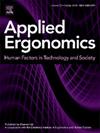Effect of riding experience and HMI on users’ trust and riding comfort in fully driverless autonomous vehicles: An on-road study
IF 3.4
2区 工程技术
Q2 ENGINEERING, INDUSTRIAL
引用次数: 0
Abstract
The wide adoption of autonomous vehicles (AVs) or robot taxis relies on technological advancements and public acceptance, which can be influenced by users’ trust in AVs and comfort during rides. Among the influential factors of riding comfort, motion sickness (MS) has attracted lots of attention in previous research, and both trust and MS have been found to be associated with human-machine interface (HMI) designs in AVs. However, previous research on trust and MS in AVs predominantly utilized driving simulations or "Wizard of Oz" methods, which failed to introduce risk and realistic vehicle motions, potentially introducing bias to conclusions. For the first time, our study investigated the impact of displaying the dynamic path trajectories of AVs on passengers' perceptions of system transparency, trust, and MS in a commercially running AV. The results from 16 participants and 32 rides revealed limited effects of the dynamic path trajectory on trust, and a discernible but statistically non-significant trend in MS alleviation. Further, we found that the initial riding experience was more important in trust enhancement than subsequent rides. These results provide insights into future HMI design in robot taxis and suggest directions for future research in trust enhancement and MS alleviation in AVs.
全无人驾驶汽车乘坐体验和人机界面对用户信任和乘坐舒适性的影响:一项道路研究
自动驾驶汽车(AVs)或机器人出租车的广泛采用取决于技术进步和公众接受程度,这可能受到用户对自动驾驶汽车的信任和乘坐过程中的舒适度的影响。在驾驶舒适性的影响因素中,晕动病(MS)在以往的研究中备受关注,而信任和MS都与自动驾驶汽车的人机界面(HMI)设计有关。然而,之前关于自动驾驶汽车信任和MS的研究主要使用驾驶模拟或“绿野仙踪”方法,这些方法没有引入风险和真实的车辆运动,可能会导致结论的偏差。我们的研究首次调查了自动驾驶汽车动态路径轨迹对商业自动驾驶汽车中乘客对系统透明度、信任和MS的感知的影响。来自16名参与者和32次乘坐的结果显示,动态路径轨迹对信任的影响有限,并且在MS缓解方面有明显但统计上不显著的趋势。此外,我们发现初次骑行体验在信任增强方面比后续骑行更重要。这些结果为未来机器人出租车的人机界面设计提供了见解,并为未来自动驾驶汽车的信任增强和MS缓解提供了方向。
本文章由计算机程序翻译,如有差异,请以英文原文为准。
求助全文
约1分钟内获得全文
求助全文
来源期刊

Applied Ergonomics
工程技术-工程:工业
CiteScore
7.50
自引率
9.40%
发文量
248
审稿时长
53 days
期刊介绍:
Applied Ergonomics is aimed at ergonomists and all those interested in applying ergonomics/human factors in the design, planning and management of technical and social systems at work or leisure. Readership is truly international with subscribers in over 50 countries. Professionals for whom Applied Ergonomics is of interest include: ergonomists, designers, industrial engineers, health and safety specialists, systems engineers, design engineers, organizational psychologists, occupational health specialists and human-computer interaction specialists.
 求助内容:
求助内容: 应助结果提醒方式:
应助结果提醒方式:


